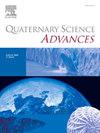Enhanced silicate weathering during glacial lowstands: new evidence from shelf sediments in the northern South China Sea
IF 2.2
Q2 GEOGRAPHY, PHYSICAL
引用次数: 0
Abstract
The enhanced silicate weathering on tropical continental shelves has been linked to the exposure of unconsolidated sediments during glacial lowstands, contributing to atmospheric CO2 consumption. However, the lack of sedimentary record from the exposed continental shelf limited our understanding of glacial weathering regimes. To address this, Core DG from the shelf of the northern South China Sea (SCS) was analyzed to investigate sediment provenance and weathering intensity during the late Quaternary (39–287 ka). Geochemical determination revealed five units (I to V) corresponding to two transgressive-regressive cycles. Sediment of Unit I, III, IV, and V primarily originated from southwestern Taiwan rivers, while Unit II derived mainly from the small streams in Hong Kong. Chemical weathering indices indicated three episodes of enhanced silicate weathering and which contributed mainly by secondary weathering due to the long-term exposure, however, with different patterns. One was the exposure of the continental shelf under favorable temperature and precipitation conditions during the early Marine Isotope Stage 6 (MIS6). Another one was the re-transport of secondary weathered sediments from the SCS shelf near Taiwan by glacially reactivated shelf channels during the end of MIS 6 and early MIS 5. This study provides new sedimentary evidence for enhanced silicate weathering during glacial lowstands, emphasizing the role of secondary weathering and source-to-sink processes in carbon sink on shelf and theimpact on the global carbon cycle.
冰期低洼区硅酸盐风化作用增强:来自南海北部陆架沉积物的新证据
热带大陆架上硅酸盐风化作用的增强与冰川低洼期松散沉积物的暴露有关,从而增加了大气中二氧化碳的消耗。然而,缺乏来自暴露的大陆架的沉积记录限制了我们对冰川风化机制的理解。为此,对南海北部陆架DG岩芯进行了分析,探讨了晚第四纪(39-287 ka)沉积物源和风化强度。地球化学测定显示了5个单位(I ~ V),对应两个海侵-退旋回。单元I、III、IV和V的沉积物主要来自台湾西南部的河流,单元II的沉积物主要来自香港的小溪。化学风化指标显示出3期硅酸盐风化增强,主要是长期暴露的次生风化作用,但模式不同。一个是早期海洋同位素阶段6 (MIS6)在有利的温度和降水条件下大陆架的暴露。另一个是在MIS 6末和MIS 5早期,冰川重新激活的陆架通道对台湾附近南海陆架次生风化沉积物的再输运。该研究为冰期低水位硅酸风化作用增强提供了新的沉积证据,强调了次生风化和源-汇过程在陆架碳汇中的作用以及对全球碳循环的影响。
本文章由计算机程序翻译,如有差异,请以英文原文为准。
求助全文
约1分钟内获得全文
求助全文
来源期刊

Quaternary Science Advances
Earth and Planetary Sciences-Earth-Surface Processes
CiteScore
4.00
自引率
13.30%
发文量
16
审稿时长
61 days
 求助内容:
求助内容: 应助结果提醒方式:
应助结果提醒方式:


